A white pimple that appears on the tip or side of the tongue causes a lot of inconvenience. To get rid of it, you need to know why these pimples appear. The appearance of small pimples on the tongue is often caused by various diseases of the oral cavity or insufficient hygienic treatment.
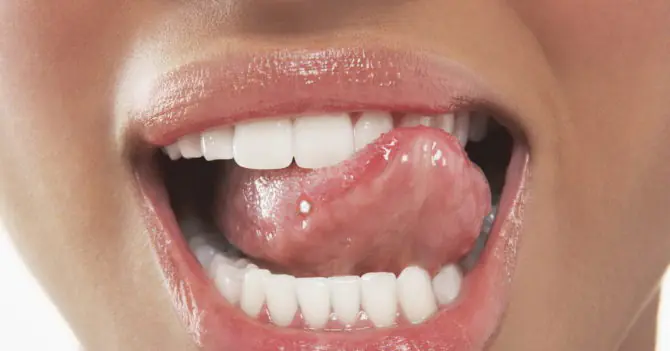
general characteristics
A pimple on the tongue is a sign of an inflammatory process, so it needs to be treated under the supervision of a doctor. These pimples are small in size - 1-2 mm, but cause severe discomfort, which is due to the good innervation of the tongue, which is necessary for taste sensitivity.
If a pimple appears on your tongue, you need to determine its type:
- red ones appear due to a decrease in immunity, allergic reactions, and an abundance of bad habits;
- whites occur against the background of a viral or fungal infection of the oral cavity;
- pink – when the taste bud becomes inflamed;
- rashes in the form of red ulcers appear with stomatitis.
The differences between different types of acne are clearly visible in the photo:
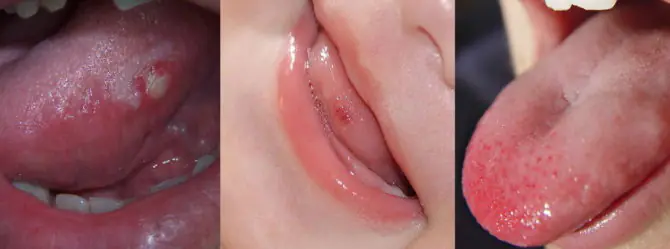
To make a correct diagnosis, you need to determine where the pimple appears on the tongue. There are several possible localizations:
- on the root - characteristic of pharyngitis, Kawasaki syndrome;
- on the side – occur with stomatitis, allergic reactions, traumatic injury;
- at the throat - appear with tonsillitis;
- at the tip - occur due to microtraumas received from eating food or hot drinks;
- on the frenulum - characteristic of glossitis.
If pimples appear under the tongue and are accompanied by swelling (increase in size), severe pain and a rise in body temperature, the patient should consult a doctor. This condition is life-threatening: a swollen organ can block the airways, and the person will not be able to breathe.
If a white pimple appears on the tongue, the organ hurts and is covered with a cheesy coating - this is a sign of a fungal disease of the mouth. The white color of the formation indicates pathologies of the gastrointestinal tract, and yellow indicates diseases of the biliary system and pancreas. To cure a pimple on the tongue, you need to get rid of the cause of its appearance.
Reasons for appearance
The reasons why a pimple on the tongue may appear are different. The most common include:
- Allergic reactions. The body reacts to the allergen, which causes a characteristic rash on the body and on the mucous membranes of the mouth. The cause of acne lies in a food, drug or chemical allergen.
- Traumatic injury. Pimples on the tongue can appear due to injuries, because they are accompanied by an inflammatory process. The integrity of tissues is damaged by the action of a sharp object (piercing), products with high acidity, and during certain dental procedures (installation of braces, prosthetics).
- Inflammatory process. Papillitis or glossitis are diseases that are infectious or traumatic in nature.
- Hormonal disorders. They provoke aphthous stomatitis, accompanied by the appearance of ulcers on the tongue that resemble pimples.
- Insufficient hygiene. If the oral cavity is not cleaned sufficiently, dead cells and food particles accumulate on the surface of the tongue, due to which bacteria multiply, causing inflammation and the appearance of small pimples.
Fungal infection. When a doctor discovers a white pimple and a cheesy coating on the tip of the tongue, he prescribes drugs for candidiasis to the patient.
Viral infections. The herpes virus can provoke the appearance of a pimple with cloudy contents on the tip or side of the tongue. Bacterial damage. A microorganism such as β-hemolytic streptococcus provokes scarlet fever, characterized by red pimples on the tongue and skin of the body. Additional reasons. Stress, smoking, deficiency of vitamins and minerals, decreased immunity, pathologies of internal organs and leukoplakia can enhance the effect of harmful factors, causing acne to break out.Unlike skin rashes on the body, pimples on the tongue are not caused by blockage of the sebaceous ducts, but by many more serious reasons.
How to treat a pimple on the tongue at home
Treatment of acne on the tongue should be aimed at eliminating the cause of its occurrence, which may be hidden in a serious internal disease. But recovery comes faster and easier if you create optimal conditions for this:
- Eliminate possible allergens, too hot or cold foods, and fruits with high acidity from the diet. Limit the consumption of spices and salt.
- Avoid fatty and fried foods, as well as bread and coconut oil.
- Limit consumption of sweet and sour desserts.
- Reduce the amount of dairy products consumed.
- Increase the volume of liquid you drink - at least 2 liters per day.
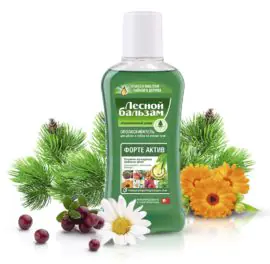
Mouthwash
Increase the amount of fruits and vegetables in your daily diet and replace coffee and fruit juices with water.
Remove from the menu foods that use marinades in their preparation. Carefully monitor oral hygiene, use toothpaste with a strong antibacterial effect (2 times a day) and special mouth rinses (after each snack). Give up bad habits: smoking tobacco and drinking alcohol. Avoid carbonated drinks.If these conditions are met, getting rid of the pimple occurs on its own. If the lump is still painful after 3–5 days, treatment by a specialist is necessary.
Treatment with medications
If a person is unable to get rid of a pimple on the tongue on his own, he should consult a dentist. After the initial examination, the doctor will prescribe a treatment regimen or refer the patient to another specialist if the disease is not related to his field of activity.
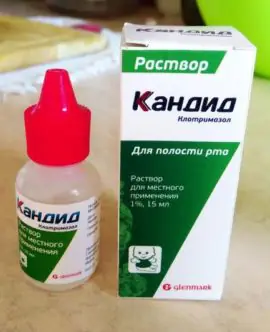
The choice of drugs depends on the type of pathogen. If the disease is caused by bacteria, antibiotics and antibacterial antiseptics are prescribed. If the disease is viral in nature, treatment with antiviral drugs is indicated. If oral thrush or fungal stomatitis is detected, treatment is carried out using antifungal drugs.
The most famous antifungal drug is Candide (see photo). This remedy can be used to treat both adults and children. First, you should get rid of the daily plaque in the mouth, then all areas of the mucous membrane are treated with Candida solution: the cheeks on the sides, gums, lips and the surface of the tongue. Positive dynamics in treatment can be noticed after 2 days. All symptoms of infection will disappear in 7–10 days. To prevent new pimples from appearing on the tongue, it is necessary to continue treatment until the course is completed.
If an infant has oral thrush, pacifiers, bottle nipples, and breasts should be treated with an antifungal agent before feeding. This will help avoid re-infection.
Other medications may be prescribed: Nystatin and Diflucan. Since such drugs have many contraindications and side effects, they should be prescribed exclusively by a dentist or other doctor.
If the formation on the tongue is painful, ointments with anesthetic properties are used. These include Kholisal and Kamistad. They fight germs that cause inflammation of the tongue, which is the cause of pain.
Since a pimple on the tongue takes more than one day to treat, anesthetic drugs help alleviate the patient’s condition. Gels with anesthetics are applied pointwise to the inflamed papillae of the tongue 30 minutes before eating and before bedtime. They are often prescribed in combination with other medications.
Treatment with natural remedies
If you still can’t get an appointment with a doctor, and the white pimple that has popped up on your tongue hurts unbearably, you can make applications, rinses and other folk remedies to alleviate the condition. To do this, you can use everything you can find at home:
- Salt. You need to make a solution by taking 1 tbsp. l. salt and 1 glass of boiled water, mixing the ingredients. You should rinse your mouth with the prepared product after each snack.
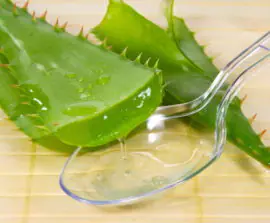
Soda. The solution is prepared from 2 tsp. soda and 1 glass of water. Then they soak gauze and wipe their cheeks, tongue and lips.- Soda + salt. You need to take 1 tsp. soda and salt, dissolve them in one glass of boiled water and treat the oral cavity with the resulting mixture. This type of treatment, such as rinsing, is only suitable for adults, as the child may swallow some of the solution.
- Aloe. The pulp of the leaf is applied to the place where the pimple popped up. Be prepared for the fact that aloe is very bitter.
- Honey. The most popular folk method of combating pain is not suitable for children due to the risk of developing allergic reactions.
With the help of folk remedies, it is impossible to cure the internal disease that caused the appearance of a pimple, serious inflammation in the oral cavity, stomatitis, candidiasis and other diseases. However, they can be used in conjunction with drug therapy, as they promote a speedy recovery. For example, the same soda changes the acidity of the oral cavity, which slows down the proliferation of fungi and bacteria.
At home, you can prepare infusions and decoctions of herbs. Inflammation of the bumps on the tongue is perfectly relieved by sage, red pimples on the tongue are removed by celandine or chamomile. To prepare any infusion you need to take 2 tbsp. l. crushed plant material and pour one glass of boiling water over them. The solution is infused for 30 minutes and then used to rinse the mouth after each snack.
If a small pimple appears on your tongue, you can make applications with the addition of oil: peach, rosehip, grape seed, clove. The procedure is carried out every 6–8 hours.
Prevention measures
To avoid acne on the tongue, you must follow these rules:
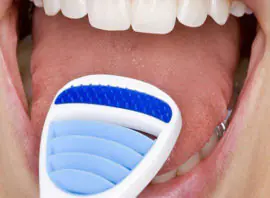
wash your hands with antibacterial soap after walking, eating, and using the restroom;- carry out hygienic treatment of the oral cavity using toothpaste and a brush at least 2 times a day;
- limit the consumption of foods that irritate the mucous membranes;
- get rid of bad habits;
- observe drinking regime;
- eat rationally and balanced.
If, even with all preventive measures, the tongue continues to become inflamed, you need to visit a dentist. Self-prescription of drugs complicates diagnosis when visiting a doctor, delays and complicates treatment, and can lead to unpleasant consequences.
Pimples on the tongue can appear in a variety of places - on the side, at the root, on the frenulum. If your tongue is severely inflamed, you need to contact your dentist so that he can prescribe proper treatment. Before your appointment, you can use home remedies. If the pimple hurts a lot, you need to use gels with an anesthetic. By following preventative measures, the chances of reoccurrence of the disease are significantly reduced.
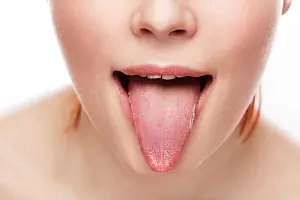
The appearance of pimples on the tongue is not taken seriously by people. Indeed, the rashes usually do not bother much; pain appears only when trying to eat something hot or when touched. However, it is contraindicated to leave such a manifestation unattended. At a minimum, you need to see a doctor to find out why it appeared.
Causes of pimples in the mouth
70% of red, white or pinkish rashes in the oral cavity, including on the tongue, indicate the presence of a serious dental disease. The asymptomatic course of the disease does not mean that the “trouble” will go away on its own. However, prescribing treatment on your own, guided by the advice of friends or recommendations from the Internet, is dangerous.
Important!
In principle, there cannot be acne on the tongue. Purulent skin rashes develop due to inflammation of the sebaceous glands, which are not present in the mouth. Accordingly, we call those pimples that appear in the oral cavity “pimples” by analogy. Just by external similarity.
There are several reasons for the appearance of irritations that visually resemble pimples:
- mechanical damage. A prick with a fish bone, a scratch, a burn from hot coffee can provoke a similar pathology;
- allergy. Not necessarily to foods; a seasonal allergic reaction is possible, manifesting itself in such an unusual way;
- viral and infectious diseases. Herpes, rubella, scarlet fever and ARVI sometimes manifest themselves as rashes in the mouth;
- fungal infection (candidiasis);
- stomatitis. Usually, with stomatitis, pimples first appear on the gums, but sometimes red spots with a whitish halo, which react sharply to touch or spicy/hot food, form over the entire lingual surface.
There is no point in waiting until diseases become chronic. In 98% of cases, such pathologies are treated quickly and inexpensively, if you do not neglect the condition and do not self-medicate.
The appearance of a pimple on the tongue: diseases and treatment
The most harmless reason for the appearance of a pimple on the tip of the tongue is mechanical damage. Regular antiseptic treatment is enough to get rid of the problem. To relieve inflammation, you can use decoctions of sage and chamomile. A prerequisite is not to touch the wound with your hands, as you risk causing a more serious infection.
Allergy
It usually manifests itself as a scattering of small pimples throughout the tongue plate; if treatment is not addressed immediately, the pathology penetrates the root of the tongue, the frenulum and affects the larynx.
Important!
The causative agent of allergies is sometimes hygiene products (toothpaste), so contact your dentist to determine what exactly causes this reaction in the body. It is problematic to calculate the consequences of an allergy; without timely detection of an aggressive allergen, serious complications may arise, including Quincke's edema.
Stomatitis
As a rule, symptoms of developing stomatitis are ulcers and erosions with a whitish coating. Visually, they are similar to acne, but are treated completely differently. In the early stages, the disease is asymptomatic, and the temperature may rise slightly. Qualified treatment is prescribed only by a dentist, depending on the nature of the damage and the prerequisites for the progression of the pathology.
Viral diseases
Usually herpes “pops up” on the lips, but its appearance on the tongue is also not uncommon. Naturally, treating a herpes rash in the mouth with antiviral ointments is impossible, and leaving it unattended is strictly contraindicated. If not treated in a timely manner, this “harmless” virus can infect any mucous membrane of the human body, including the brain. Don't take risks if you find watery scarlet or pinkish pimples in your mouth; consult a doctor immediately.
Candidiasis
A fungal infection is usually noticed when the entire oral mucosa is “strewn” with pimples with a white coating. In addition, with thrush, the temperature rises slightly, lethargy appears and appetite disappears. Self-rinsing with antifungal agents will help relieve symptoms, but the full range of treatment must be completed to eliminate the risk of relapse.
Unfortunately, there is no panacea for oral diseases yet. You can endlessly listen to advice and hope that it will help. But it is much wiser and safer for your health to visit a dentist to know exactly what to treat and how.
If you have a problem similar to that described in this article, be sure to contact our specialists. Don't diagnose yourself!
Pimples on the tongue can be caused by bacterial, viral infections, physical damage, and allergic reactions. Each neoplasm has its own causes, treatment methods and methods of prevention.
Types of acne
Pimples in the oral cavity can vary in appearance and causes. It is worth paying attention to the most common ones.
Papillitis
Inflamed and swollen papillae of the tongue are called papillitis.
The causes of occurrence are always external stimuli:
- An unsuitable toothbrush;
- Acidic or alkaline effects on the oral cavity;
- Burns from boiling water;
- Irritation from foods, such as frequent consumption of candy;
- Frequent heartburn and acid reflux from the stomach;
- Tongue biting injuries;
- Cuts on the tongue from a chipped tooth or filling;
- Injuries to the tongue from rough food, such as fish bones.
To combat papillitis, it is enough to eliminate the cause and treat with an antiseptic for 2-3 days. Healing occurs on day 2, provided that the inflammation is not a consequence of infection.
Infectious inflammation is called glossitis.
Glossitis
Degenerative changes in the tongue, its hardening, bleeding ulcers, bad breath, heavy plaque - all these symptoms indicate the disease glossitis caused by infection.
- Bacterial contamination of the oral cavity;
- Iron-deficiency anemia;
- Vitamin deficiency, in particular lack of B vitamins;
- Lichen planus;
- Syphilis, etc.
To combat glossitis, studies are prescribed to clarify the cause. After this, the patient usually undergoes a course of antibiotic therapy or antiviral drugs. For topical use, it is recommended to use antiseptics, manganese solution, miramistin, chlorhexidine, furatsilin at the patient's choice.
If a lack of vitamins or elements (iron) is detected, a course of multivitamins and iron supplements is prescribed. Sometimes injections or tablets of B vitamins, the administration of which must be prescribed by the doctor, since when taken simultaneously with certain foods, the vitamins are not absorbed.
Contaminated mucous membrane – stomatitis
Small ulcers on the tongue, cheeks, and the inside of the lips that itch, hurt and interfere with chewing food. Usually occur due to contamination of the mucous membrane in young children, when licking toys, against the background of weakened immunity. However, it also occurs in adults.
- Oral contamination from toys in children;
- Smoking and alcohol abuse in adults;
- Weakened immunity after suffering a viral infection;
- Injured mucous membrane.
Treatment usually consists of antiseptic treatment of the mouth. If the child is small and cannot rinse his mouth, then it is necessary to lubricate the oral cavity with a swab or cotton pad soaked in antiseptic. They also carry out procedures that strengthen general immunity: walks in the fresh air, sunbathing, taking multivitamins, a nutritious varied diet, and sufficient fluid intake.
Aphthous stomatitis
Manifested by the appearance of extensive ulcers in the oral cavity. It is also called geographical, since the lesions resemble a map. Bacterial causes of these lesions have not been identified. Typically, lesions occur as a result of allergic reactions, vitamin or mineral deficiencies, a general decrease in immunity, hereditary predisposition, diseases of the gastrointestinal tract, and defects of the hematopoietic system.
If there is no improvement within three days of antiseptic measures, then a visit to the doctor is essential.
Candidiasis. Fungal stomatitis (thrush)
A fungal disease, commonly referred to as thrush. It occurs in both adults and children. The latter become infected exclusively through contact with the mother, through the birth canal or infected nipples, during breastfeeding.
It has symptoms: dry mouth, itching and burning, a white coating under which red tumors are localized, which sometimes bleed.
In children, it is usually sufficient to treat the oral cavity with a soda solution (pour one teaspoon of soda into a glass of boiling water, stir and cool).
For adults, it is necessary to take a course of antifungal drugs, such as pimafucin, clotrimazole, Diflucan, and others. It is very important not to stop taking the drug, even if there is improvement. This threatens the strengthening of the fungus and the return of lesions on a larger scale. For adult carriers of the fungus, it is necessary to undergo treatment together with a sexual partner to avoid a recurrence of symptoms.
Viral infections and STDs
Painful oral rashes can be caused by viral infections and sexually transmitted diseases (STDs). This can be either the herpes simplex virus, or HIV infection, gonorrhea, chlamydia, or syphilis.
It is very important to treat these diseases without turning them into a chronic form, otherwise they cannot be completely cured, and it is only possible to stop exacerbations.
So, for example, with syphilis, the incubation period is 14-50 days, during which time a pimple with rough walls appears in the place where the infection has penetrated, including in the mouth; it goes away, on average, after 30 days, becoming chronic. and, if no action is taken, subsequent manifestations affect the central nervous system and lead to death.
If you are infected with an STD, you must contact a venereologist, who will prescribe the treatment necessary in a particular case.
Oral cancer
Neoplasms in the mouth, which in the early stages present as small ulcers, can be easily confused with ordinary stomatitis. At first, the discomfort is local, however, if the symptoms are ignored, the pain can intensify and radiate to the head and ears.
If left untreated, a malignant tumor grows and interferes with leading a normal lifestyle. Makes swallowing difficult and increases salivation.
There are no specific reasons for the formation of cancer. But there are indirect factors that increase risks:
- Smoking;
- Alcohol abuse;
- Systematic injury to the oral mucosa with dentures, fillings, and rough food;
- According to statistics, men over 60 years of age, smokers, and people who regularly consume spicy foods are more susceptible to oral cancer.
Treatment is prescribed depending on the stage at which the patient consulted an oncologist; most often it is radiation therapy, chemotherapy, and, in extreme cases, surgery to remove the tumor.
Kawasaki disease
A disease with an acute course and high fever, most often affecting children under 10 years of age. The main causes of occurrence have not been identified, but based on observations, it has been noted that children of the Asian race are more likely to get sick. The causes of the disease include the following:
- Staphylococcal infections;
- Streptococcal infections;
- Viral infections (herpes, Epstein Barr and others);
- Genetic predisposition.
The symptoms of the disease are extensive, when the body is affected, the temperature rises and lasts for several days, enlarged lymph nodes in the neck, swelling of the tongue and lips, aching joints, severe deterioration in the functioning of the cardiovascular system, possible appearance of arterial aneurysms and myocardial infarction are noted. The disease is dangerous due to complications on the heart and central nervous system.
Treatment consists of intravenous gamma globulin and aspirin during the recovery phase and in subsequent years. Aspirin is prescribed to reduce the risk of blood clots and the drug is not stopped until the aneurysm shrinks or goes away completely. Treatment takes place in a specialized clinic.
Scarlet fever
Streptococcal infection, which is accompanied by suppuration of the tonsils (sore throat), a red rash, swelling of the tongue, and high fever.
The tongue when affected by scarlet fever is bright burgundy, the rash is all over the body, which disappears without a trace on the 3rd day after its appearance. This is a reaction to a toxin formed during the breakdown of streptococcus in a child’s body.
Treatment is traditional, using antibiotics. Antiseptics are used locally.
If treatment is not started in a timely manner, complications occur, the walls of blood vessels become thinner, which can cause hemorrhage anywhere in the body and in the brain. The liver, adrenal glands and kidneys can also be affected by purulent inflammation. If treatment is delayed, pneumonia may develop.
Causes of appearance depend on the location and color of acne
Depending on where pimples are located in the oral cavity, you can understand the reason for their appearance, but only a doctor can accurately diagnose based on laboratory tests of smears from the mucous membranes.
Under the tongue
If pimples appear under the tongue, this may indicate candidiasis, allergies, or herpetic infections. And also indicate diabetes mellitus, or a lack of B vitamins.
On the side
Pimples on the side of the tongue can also indicate viral infections, cancer pathogens, or mechanical damage.
Pimples on the tip
Most often, this is stomatitis caused by injury from rough food, such as seeds. Herpes is also possible.
Pimples on the root of the tongue
Infectious pimples such as streptococci are usually localized at the root. Possible sore throat, scarlet fever.
Yellow pimples
Yellow pimples, especially those with purulent contents, most often indicate the venereal nature of their appearance; it is necessary to consult a venereologist.
White pimples
Caused by candida fungus and require treatment for thrush. It may appear after mechanical trauma or biting.
Red pimples
Red pimples may indicate Kawasaki disease, herpetic rashes, and frequent consumption of spicy, hot foods. For frequent burns of the mucous membrane.
Black pimples
May be caused by cancerous lesions, or irritation when the tongue is pierced.
How to quickly get rid of acne, remedies and treatment
To quickly get rid of unpleasant sensations, you should use a simple rinsing method. For candidiasis, an alkaline solution, for all others, antiseptic liquids are suitable, except for peroxide, it dries out the mucous membrane. Furacilin, miramistin, chlorhexidine have proven themselves in eliminating unpleasant symptoms.
Healthy and balanced diet
When treating acne on the tongue, it is necessary to adhere to a diet that excludes rough foods, spicy, salty, and excessively hot dishes. And any products that can injure the oral mucosa.
Avoid smoking, as it provokes not only bad breath, but also cancerous tumors, necrosis of the papillae, which subsequently leads to inability to distinguish tastes.
Is it possible to treat acne on the tongue on your own?
In case of minor changes in the mucous membrane and errors in nutrition or damage to the mucous membrane, you can rinse the mouth with antiseptics and follow a “soft” diet for a couple of days, however, if neoplasms appear without objective reasons, it is necessary to show the pimples to the doctor, since early diagnosis of the disease leads to recovery in the vast majority cases. With extensive lesions, self-medication cannot be done. And the sooner the doctor prescribes treatment, the sooner recovery will occur.



